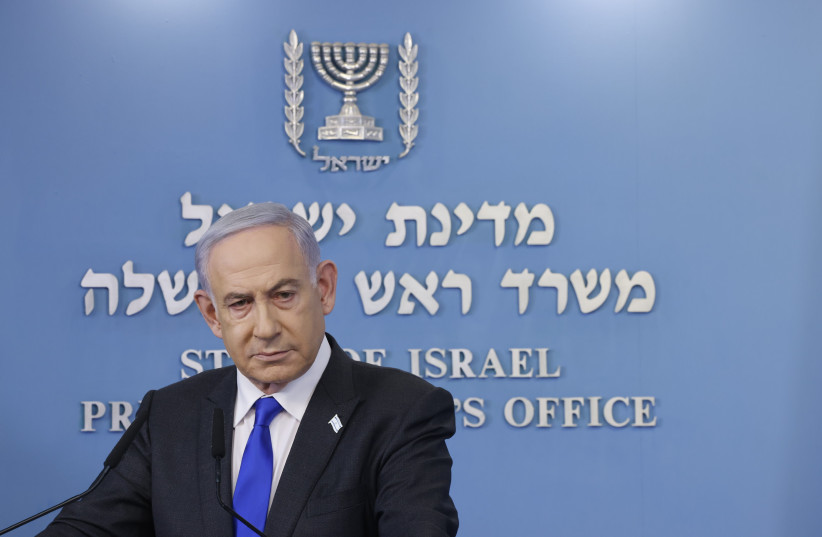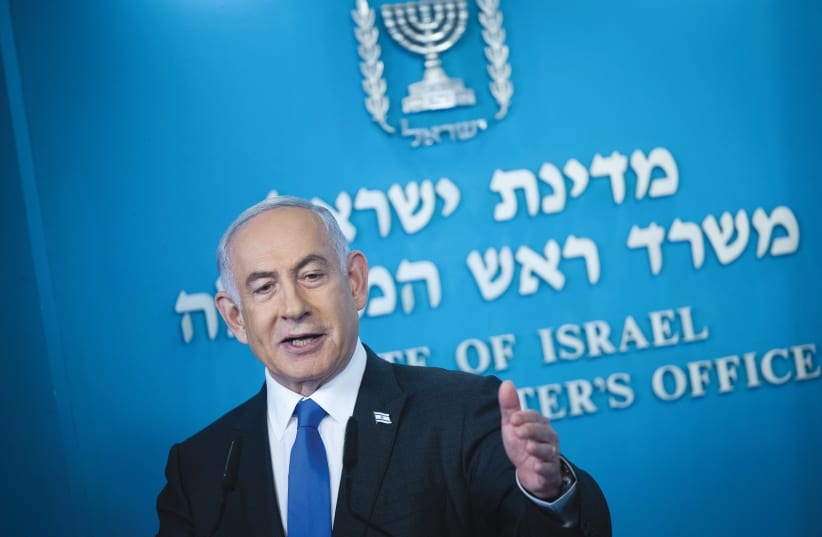The term “total victory” has been on Prime Minister Benjamin Netanyahu’s lips a great deal recently.
It has about it the ring of a phrase adopted by Franklin Roosevelt and Winston Churchill at the 1943 Casablanca Conference during World War II: “unconditional surrender,” a statement that the Allies would be content with nothing less than the complete and utter defeat of the Nazi enemy.
There would be no armistice, no haggling over the terms of a cessation of hostilities. Unconditional surrender became the ultimate war aim of the Allies.
Total victory can be described as Netanyahu’s ultimate war aim. It implies both the complete elimination of Hamas as a fighting force and the liberation of all the hostages held by the terror organization. The military defeat of Hamas would also mean the end of its control of the Gaza Strip.
How Gaza is to be administered and its reconstruction approached are urgent problems that will require attention and international cooperative action for the “day after.”


Netanyahu used the term “total victory” several times on February 8 in response to the most recent hostage-for-ceasefire offer by Hamas.
In November 2023, negotiations conducted with the help of intermediaries produced a pause in the war in Gaza and the release of 240 Palestinian security prisoners by Israel in exchange for 105 of its hostages held by Hamas. Ever since, there has been a to-and-fro in an attempt to reach another deal acceptable to both Hamas and Israel.
Hamas’s aim has been to secure Israel’s withdrawal from Gaza and the release of all Palestinian prisoners in Israeli jails.
Israel is seeking the liberation of all the hostages held by Hamas in return for as short a pause in the fighting as possible, to prevent Hamas from regrouping and reversing Israel’s gains in the Strip.
Talks in Paris involving intelligence chiefs from Israel, the United States, and Egypt, and the prime minister of Qatar resulted, on January 30, in new proposals for a ceasefire and the release of hostages. Hamas said it was studying them. A senior Hamas official told Reuters that the proposal involved a three-stage truce, during which the group would first release remaining civilians among the hostages it had captured on October 7, then soldiers, and finally the bodies of hostages that were killed.
Hamas chief Ismail Haniyeh left his luxurious home in Doha to fly to Cairo to discuss them. While the people of Gaza have undergone untold misery following Hamas’s horrendous actions on October 7, the leaders of Hamas have been enjoying sumptuous lifestyles in Qatar. Between them, Haniyeh, Moussa Abu Marzuk, and Khaled Mashal are estimated by the New York Post to be worth a staggering $11 billion, accumulated heaven-knows-how.
The discussions in Cairo resulted in a counter-offer from Hamas, made public on February 7. Using the same three-stage formula but spread over 135 days, Hamas proposed a 45-day temporary halt to military operations and the repositioning of Israeli forces outside populated areas. Hamas would release Israeli civilian women and children together with elderly and sick hostages in return for the release of Palestinian women, children, elderly, and sick security prisoners from Israeli jails.
The second 45 days would see Israeli forces withdraw outside the Gaza Strip and Hamas release all Israeli male civilian hostages and all IDF members being held, in exchange for other Palestinian prisoners.
In the third 45 days, the exchange of bodies and remains by both sides would see the virtual end to the conflict. Israel would have withdrawn from Gaza and all the hostages would have been released.
Netanyahu’s reaction? Total rejection.
Dubbing the proposals “delusional,” he renewed his pledge to destroy Hamas. At a media conference he said that total victory in Gaza was within reach and there was no alternative for Israel but to bring about the collapse of Hamas. He insisted that total victory against Hamas was the only solution to the Gaza war.
“Continued military pressure,” he said, “is a necessary condition for the release of the hostages.”
Is Netanyahu right? Or is he – as a tranche of Israeli opinion holds in a somewhat ungenerous interpretation of his motives – mainly interested in the personal and political advantages he derives from spinning out the war scenario for as long as possible?
US SECRETARY of State Anthony Blinken was less clear-cut in his reaction. At a late-night press conference held in a Tel Aviv hotel, he suggested that forging a truce agreement was not a lost cause.
“There are clearly nonstarters in what [Hamas has] put forward,” he said, without specifying what the nonstarters were. “But we also see space – in what came back – to pursue negotiations, to see if we can get to an agreement. That’s what we intend to do.”
One obvious non-starter is that at the end of the Hamas-proposed process, the terror organization would be left in control of a Gaza Strip from which the IDF had withdrawn completely, and would be totally free to rebuild its military infrastructure and resume its relentless campaign aimed at destroying Israel and killing Israelis.
Another, from Washington’s point of view, is that Hamas is fundamentally and inflexibly opposed to the two-state solution, that article of faith so cherished by the United Nations, US, European Union, United Kingdom, and much of world opinion.
And here is the great dilemma, for a negotiated ceasefire does have an appeal to those concerned – above all for the fate of Israel’s hostages still in Hamas’s hands – and it commends itself also to the great swath of world opinion concerned above all for the protection of the Gazan civilian population.
It is a prospect, however, unlikely to commend itself to Netanyahu, who has spelled out the long-term implications for Israel.
These would be: a reversal to the failed policies of the past, with Hamas, Israel’s implacable enemy, reinstalled in power a hand’s breadth away from Israeli citizens, and the entire nation in range of ever-more-sophisticated missiles and rockets.
Netanyahu is attempting to square the circle by arguing that the best hope of liberating the hostages lies not in deals that allow Hamas to regain its control of Gaza but in maintaining Israel’s military pressure until the complete defeat of Hamas – in other words, total victory.
The writer is the Middle East correspondent for Eurasia Review. His latest book is Trump and the Holy Land: 2016-2020. Follow him at: a-mid-east-journal.blogspot.com.
